�
BUT HOW DO IT KNOW?
The Basic Principles of Computers
For Everyone
By
J. Clark Scott
Copyright © 2009 by John Clark Scott
Computer design incorporated herein
Copyright © 2009 by John Clark Scott
All Rights Reserved
Published by John C. Scott, Oldsmar, FL 34677
ISBN 978-0-615-30376-5
buthowdoitknow.com
Cover art, photography and design by Alexander C. Scott III
artbyalexscott.com
Printed in the United States of America
First Edition : July 2009
10 9 8 7 6 5 4 3 2 1
�
Table of Contents
Table of Contents
Introduction
Just the Facts Ma’am
Speed
Language
Just a Little Bit
What the…?
Simple Variations
Diagrams
Remember When
What Can We Do With A Bit?
A Rose by Any Other Name
Eight Is Enough
Codes
Back to the Byte
The Magic Bus
More Gate Combinations
First Half of the Computer
Numbers
Addresses
The Other Half of the Computer
More Gates
Messing with Bytes
The Left and Right Shifters
The NOTter
The ANDer
The ORer
The Exclusive ORer
The Adder
The Comparator and Zero
Logic
The Arithmetic and Logic Unit
More of the Processor
The Clock
�
Doing Something Useful
Step by Step
Everything’s Under Control
Doing Something Useful, Revisited
What’s Next?
The First Great Invention
Instructions
The Arithmetic or Logic Instruction
The Load and Store Instructions
The Data Instruction
The Second Great Invention
Another Way to Jump
The Third Great Invention
The Clear Flags Instruction
Ta Daa!
A Few More Words on Arithmetic
The Outside World
The Keyboard
The Display Screen
Another Code
The Final Word on Codes
The Disk
Excuse Me Ma’am
That’s All Folks
Hardware and Software
Programs
The Operating System
Languages
The File System
Errors
Computer Diseases?
Firmware
Boots
Digital vs. Analog
I Lied – Sort of
Full Disclosure
Philosophy
�
Introduction
The title of this book is the punch line of an old joke that goes like this:
Joe is a very nice fellow, but has always been a little slow. He goes into a store where a
salesman is standing on a soapbox in front of a group of people. The salesman is pitching the
miracle new invention, the Thermos bottle. He is saying, "It keeps hot food hot, and cold
food cold...." Joe thinks about this a minute, amazed by this new invention that is able to
make a decision about which of two different things it is supposed to do depending on what
kind of food you put in it. He can’t contain his curiosity, he is jumping up and down, waving
his arm in the air, saying “but, but, but, but…” Finally he blurts out his burning question
"But how do it know?"
You may or may not have laughed at the joke, but the point is that Joe looked at what this
Thermos bottle could do, and decided that it must be capable of sensing something about its
contents, and then performing a heating or cooling operation accordingly. He thought it must
contain a heater and a refrigerator. He had no idea of the much simpler principle on which it
actually operates, which is that heat always attempts to move from a hotter area to a cooler
area, and all the Thermos does is to slow down this movement. With cold contents, the
outside heat is slowed on its way in, and with hot contents, the heat is slowed on its way
out. The bottle doesn't have to "know" in order to fulfill its mission, and doesn't heat or cool
anything. And eventually, the contents, hot or cold, do end up at room temperature. But
Joe's concept of how the bottle worked was far more complicated than the truth.
So the reason for the book title, is that when it comes to computers, people look at them, see
what they can do, and imagine all sorts of things that must be in these machines. Or they
imagine all sorts of principles that they must be based on, and therefore what they may be
capable of. People may assign human qualities to the machine. And more than a few find
themselves in situations where they feel that they are embarrassing themselves, like our
friend in the joke, Joe.
But computers are actually quite easy to understand. Of course computers have a greater
number of parts than a Thermos bottle, but each part is extremely simple, and they all
operate on a very simple, very easy to understand principle.
With the Thermos, the principle is that of the motion of heat. This is something we can
observe in life. We see ice cubes melting when they are removed from the freezer, and we see
the hot meal cooling off on the table when the family is late for dinner.
In the computer, the principle on which it operates has to do with electricity, but that doesn't
mean that it is hard to understand. If you have observed the fact that when you turn on a
light switch, a light bulb lights up, and when you turn the switch off, the light goes dark, then
�
you have observed the principle on which computers operate. That is about all you need to
know about electricity to understand computers.
�
Just the Facts Ma’am
This book is not primarily intended to be a textbook. There are no problems to do at the end
of each chapter. Its intention is simply to demystify the subject of computers for anyone
who has ever wondered what’s going on inside of that box. Of course, it also makes a perfect
introduction to computers for a young person who will ultimately go on to get a PhD in
Computer Science. But it should be easily understandable by housewives, senior citizens and
children who can read well. It should be understandable to plumbers and street sweepers. It
requires no previous technical education. It only requires that you can read the language, you
can turn a light bulb on and off, and you can do very simple addition on the order of 8+5=13.
This book presents the complete essentials that make up a computer. It presents every piece
and part, in the proper order so that each one will make sense, and can be understood. Every
part is explained fully, and every new word is defined thoroughly when it is first used. Any
attempt to simplify the subject further would leave gaps in the big picture where someone
would still have to guess how the parts work together, and you just wouldn’t ever have that
“Aha, I get it!” moment that I think you’ll soon have.
This book is not a ‘dumbed-down’ version of some college textbook. It is a complete
explanation of the basic principles of computers. It is a technical book, but so is a cookbook
and so is a driver’s education handbook. This book just starts at the beginning and defines
every item needed to understand the machine. No matter what someone already knows about
computers, this will fill in any missing pieces and put them all together into something that
makes sense.
Even our friend, Joe, could understand this book with diligent study. There are thousands of
words and ideas associated with the field of computers that make the whole subject seem like
a mess. But the basic concepts underlying them are simple.
In this book, there will not be volumes of trivia about the construction or history of
computers, just the essentials, no more and no less. Each part of the computer has a simple
function, and when they are connected together, you end up with a useful machine called a
computer.
There is nothing to memorize in this book. Each chapter is designed to give you a new idea
that you didn’t have before, or if it is something that you had heard about previously, it
always seemed confusing. Each idea is very simple, and one thing leads to the next. Each
chapter presents an idea. Each idea is simple and easy to understand. Later chapters present
ideas that build on the ideas from previous chapters.
If someone were to write a book about how to build a house, there could be various levels of
detail. The simplest book would say, “lay a foundation, put up the walls, cover with a roof,
�
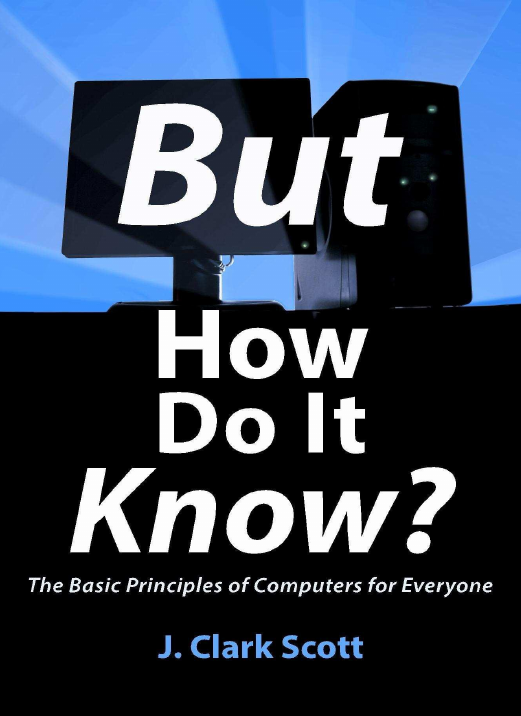
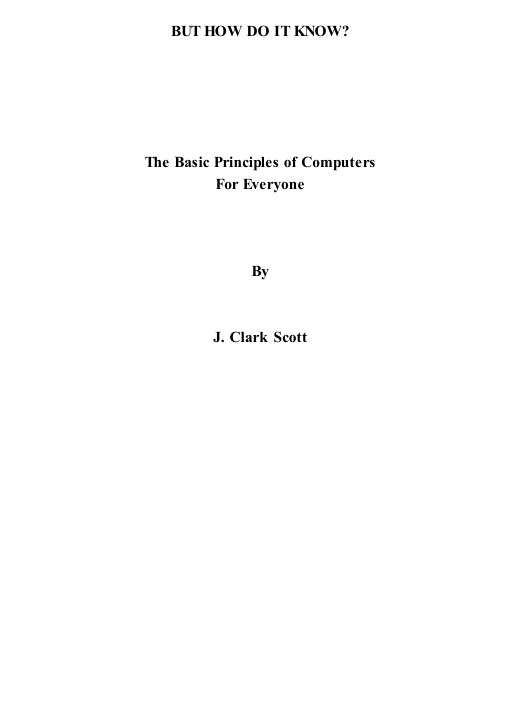
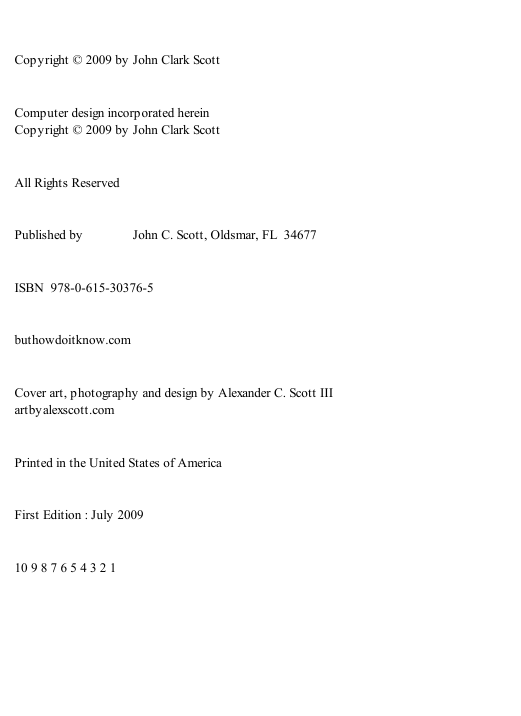
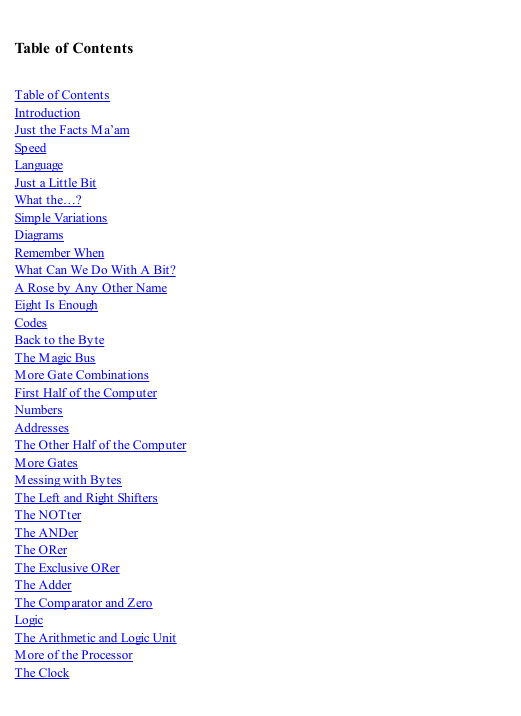

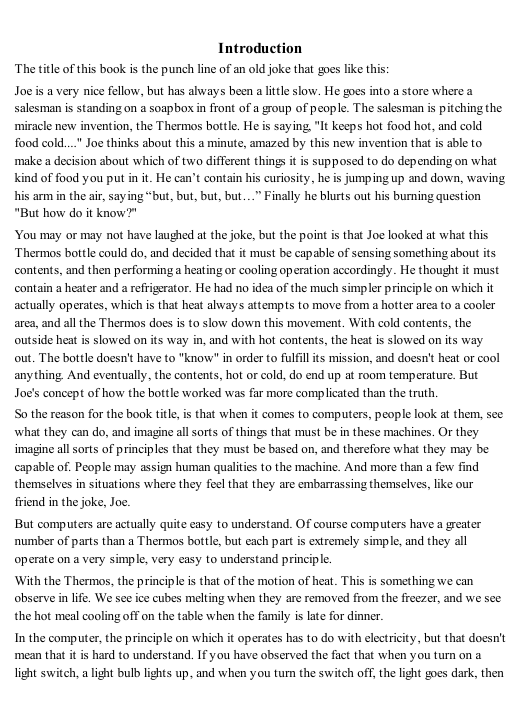










 2023年江西萍乡中考道德与法治真题及答案.doc
2023年江西萍乡中考道德与法治真题及答案.doc 2012年重庆南川中考生物真题及答案.doc
2012年重庆南川中考生物真题及答案.doc 2013年江西师范大学地理学综合及文艺理论基础考研真题.doc
2013年江西师范大学地理学综合及文艺理论基础考研真题.doc 2020年四川甘孜小升初语文真题及答案I卷.doc
2020年四川甘孜小升初语文真题及答案I卷.doc 2020年注册岩土工程师专业基础考试真题及答案.doc
2020年注册岩土工程师专业基础考试真题及答案.doc 2023-2024学年福建省厦门市九年级上学期数学月考试题及答案.doc
2023-2024学年福建省厦门市九年级上学期数学月考试题及答案.doc 2021-2022学年辽宁省沈阳市大东区九年级上学期语文期末试题及答案.doc
2021-2022学年辽宁省沈阳市大东区九年级上学期语文期末试题及答案.doc 2022-2023学年北京东城区初三第一学期物理期末试卷及答案.doc
2022-2023学年北京东城区初三第一学期物理期末试卷及答案.doc 2018上半年江西教师资格初中地理学科知识与教学能力真题及答案.doc
2018上半年江西教师资格初中地理学科知识与教学能力真题及答案.doc 2012年河北国家公务员申论考试真题及答案-省级.doc
2012年河北国家公务员申论考试真题及答案-省级.doc 2020-2021学年江苏省扬州市江都区邵樊片九年级上学期数学第一次质量检测试题及答案.doc
2020-2021学年江苏省扬州市江都区邵樊片九年级上学期数学第一次质量检测试题及答案.doc 2022下半年黑龙江教师资格证中学综合素质真题及答案.doc
2022下半年黑龙江教师资格证中学综合素质真题及答案.doc